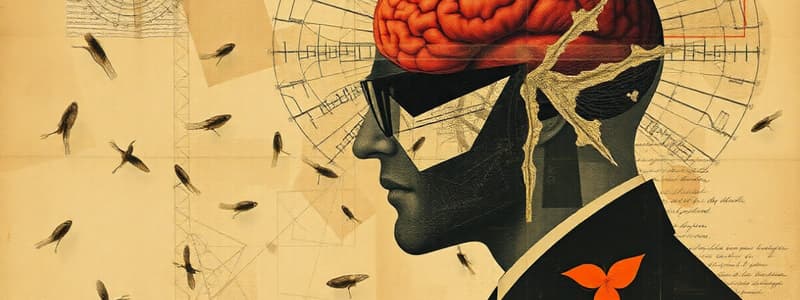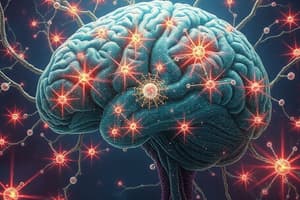Podcast
Questions and Answers
What significant theory did Santiago Ramón y Cajal establish regarding nerve cells?
What significant theory did Santiago Ramón y Cajal establish regarding nerve cells?
- Nerve cells are separate units. (correct)
- Nerve cells can regenerate completely.
- Nerve cells are composed of multiple layers.
- Nerve cells are continuous networks.
Which innovation did Cajal utilize to enhance his research on the nervous system?
Which innovation did Cajal utilize to enhance his research on the nervous system?
- Electron microscopy.
- Golgi's tissue-staining methods. (correct)
- X-ray crystallography.
- Fluorescent imaging techniques.
In what year did Santiago Ramón y Cajal publish his landmark work on the structure of the nervous system?
In what year did Santiago Ramón y Cajal publish his landmark work on the structure of the nervous system?
- 1906
- 1910
- 1887
- 1899 (correct)
Which of the following statements correctly describes Cajal's early life interests?
Which of the following statements correctly describes Cajal's early life interests?
What impact did technological advancements in optical lenses have on Cajal's research?
What impact did technological advancements in optical lenses have on Cajal's research?
In which year did Cajal win the Nobel Prize?
In which year did Cajal win the Nobel Prize?
Which statement reflects the limitations of microscopes prior to the 1870s?
Which statement reflects the limitations of microscopes prior to the 1870s?
What relationship did Cajal have with drawing during his early life?
What relationship did Cajal have with drawing during his early life?
What aspect of Camillo Golgi's work was instrumental in visualizing nerve endings?
What aspect of Camillo Golgi's work was instrumental in visualizing nerve endings?
Which statement accurately represents the differences between Golgi and Cajal's theories?
Which statement accurately represents the differences between Golgi and Cajal's theories?
How did Cajal modify Golgi's staining technique over the years?
How did Cajal modify Golgi's staining technique over the years?
What was a significant outcome of Cajal's findings regarding the nervous system?
What was a significant outcome of Cajal's findings regarding the nervous system?
What unique characteristic did Cajal's artistic representations of nerve cells possess?
What unique characteristic did Cajal's artistic representations of nerve cells possess?
Flashcards
Who is Santiago Ramón y Cajal?
Who is Santiago Ramón y Cajal?
Santiago Ramón y Cajal was a Spanish neuroscientist who won the Nobel Prize for his work on the nervous system.
What inspired Cajal's research?
What inspired Cajal's research?
Cajal was fascinated by drawing and medicine, which led him to study the microscopic structure of the nervous system.
Why was it difficult to study the nervous system before the 1870s?
Why was it difficult to study the nervous system before the 1870s?
Prior to the 1870s, microscopes lacked the clarity to show the detailed structure of the nervous system.
What breakthrough helped Cajal study the nervous system in detail?
What breakthrough helped Cajal study the nervous system in detail?
Signup and view all the flashcards
What theory did Cajal challenge?
What theory did Cajal challenge?
Signup and view all the flashcards
What was Cajal's key publication?
What was Cajal's key publication?
Signup and view all the flashcards
What recognition did Cajal receive for his work?
What recognition did Cajal receive for his work?
Signup and view all the flashcards
Describe the diagram accompanying Cajal's work.
Describe the diagram accompanying Cajal's work.
Signup and view all the flashcards
What is the Golgi method?
What is the Golgi method?
Signup and view all the flashcards
How did Cajal modify Golgi's method?
How did Cajal modify Golgi's method?
Signup and view all the flashcards
What is the reticular theory?
What is the reticular theory?
Signup and view all the flashcards
What is the neuron doctrine?
What is the neuron doctrine?
Signup and view all the flashcards
Why were Cajal's drawings significant?
Why were Cajal's drawings significant?
Signup and view all the flashcards
Study Notes
Santiago Ramón y Cajal
- Nobel Prize-winning neuroscientist
- Used microscopes to study the nervous system
- First to understand nervous system consists of individual communicating cells
- Improved tissue staining techniques to visualize and study nervous system better
Early Life and Interests
- Born in Northern Spain, rebellious child
- Passion for drawing
- Father was a doctor and taught anatomy
- Combined artistic talents and scientific interests
- Wanted to be an artist, but his father encouraged medical school
- His artistic talents merged with scientific interests
Microscopes and Staining
- Used microscopes to study muscle tissue
- Used savings to buy microscope
- Improved microscopes increased magnification and resolution
- New staining techniques made individual cells more visible
- Focused on histology (microscopic anatomy) of nervous system
- Studied brain tissue using these techniques
- Found improved staining techniques to study nervous system better, and made detailed drawings of brain tissue sections
Technological Advancements
- Modified Golgi's tissue-staining method
- Developed and improved techniques
- Utilized improved staining for easier visualization of brain tissue
- Made sketches of tissues he studied
Discredited Theory
- Before 1888, it was thought that nervous cells were connected in a continuous web
- Cajal's work in 1888 showed cells are independent units
- Cajal's work helped disprove the idea of a continuous nerve network
Major Work
- Published first volume of a book on the structure of the nervous system in 1899
- Created hundreds of illustrations of the human brain and nervous system
- His detailed illustrations helped clarify complex structures, aided scientific studies
Prize Winner
- Shared Nobel Prize with Golgi in 1906
- Recognition for work on the structure of the nervous system
- Awarded Nobel Prize because of his advanced techniques and detailed drawings
Studying That Suits You
Use AI to generate personalized quizzes and flashcards to suit your learning preferences.





